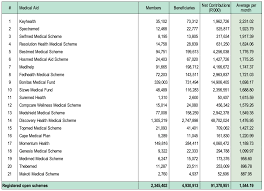
Navigating the World of Medical Aid Plans: A Comprehensive Guide
Understanding Medical Aid Plans: A Comprehensive Guide
Medical aid plans play a crucial role in providing individuals and families with access to quality healthcare services. These plans, also known as health insurance schemes, help individuals cover the costs of medical treatments, consultations, and procedures. Understanding how medical aid plans work is essential for making informed decisions about your healthcare coverage.
Types of Medical Aid Plans
There are various types of medical aid plans available to cater to different needs and budgets:
- Hospital Plan: Covers hospitalization expenses, such as accommodation, surgery, and medication.
- Comprehensive Plan: Offers a wide range of benefits, including hospitalization, day-to-day medical expenses, chronic medication, and preventative care.
- Primary Care Plan: Focuses on primary healthcare services like doctor consultations, basic tests, and medication.
- Affinity Schemes: Tailored plans for specific groups or professions that may offer specialized benefits.
Key Considerations When Choosing a Medical Aid Plan
When selecting a medical aid plan, it’s important to consider the following factors:
- Coverage: Ensure the plan covers the medical services you need, including hospitalization, chronic conditions management, and preventative care.
- Cost: Evaluate the monthly premiums, co-payments, and limits to determine affordability.
- Network Providers: Check if your preferred doctors, hospitals, and specialists are part of the plan’s network to avoid out-of-network costs.
- Add-on Benefits: Assess additional benefits like dental care, optical services, or wellness programs that may enhance your coverage.
The Benefits of Having a Medical Aid Plan
Having a medical aid plan offers numerous advantages:
- Financial Security: Protects you from unexpected medical expenses that could lead to financial strain.
- Prompt Access to Healthcare: Ensures timely access to medical services without long waiting periods.
- Better Health Outcomes: Encourages preventive care and early intervention for improved health outcomes.
In conclusion, understanding the different types of medical aid plans and their benefits is essential for choosing the right coverage that meets your healthcare needs. By carefully evaluating your options and considering key factors like coverage and cost, you can select a plan that provides peace of mind and comprehensive healthcare protection.
8 Frequently Asked Questions About Medical Aid Plans
- What is a medical aid plan?
- How do medical aid plans work?
- What types of medical aid plans are available?
- How do I choose the right medical aid plan for me?
- What does a medical aid plan typically cover?
- Are pre-existing conditions covered under medical aid plans?
- What are the costs associated with a medical aid plan?
- Can I add family members to my medical aid plan?
What is a medical aid plan?
A medical aid plan, also known as a health insurance scheme, is a comprehensive healthcare coverage option that individuals and families can enroll in to help cover the costs of medical treatments, consultations, and procedures. These plans provide financial assistance for various healthcare services, including hospitalization, doctor visits, medication, and specialized treatments. By subscribing to a medical aid plan, individuals can access quality healthcare services without bearing the full burden of expenses out of pocket. Medical aid plans offer different levels of coverage and benefits tailored to meet the diverse needs and budgets of individuals seeking reliable healthcare protection.
How do medical aid plans work?
Medical aid plans function as health insurance schemes that individuals or families subscribe to in order to access a range of healthcare services. When enrolled in a medical aid plan, members pay monthly premiums to the provider, which entitles them to coverage for various medical expenses. The extent of coverage depends on the type of plan chosen, with options ranging from hospital plans that cover inpatient care to comprehensive plans that include outpatient services and preventative care. Members can typically seek treatment from network providers affiliated with the plan to benefit from discounted rates and seamless claims processing. Medical aid plans aim to alleviate the financial burden of healthcare costs and ensure that individuals have timely access to necessary medical treatments.
What types of medical aid plans are available?
When considering medical aid plans, individuals often inquire about the available types of coverage options. Medical aid plans come in various forms to suit different healthcare needs and preferences. Common types include Hospital Plans, which focus on covering hospitalization expenses like surgeries and medications; Comprehensive Plans that offer a wide range of benefits including hospitalization, day-to-day medical expenses, chronic medication, and preventative care; Primary Care Plans that emphasize primary healthcare services such as doctor consultations and basic tests; and Affinity Schemes that provide specialized benefits tailored for specific groups or professions. Understanding the distinctions between these plan types is crucial in selecting the most suitable coverage for one’s individual healthcare requirements.
How do I choose the right medical aid plan for me?
When selecting the most suitable medical aid plan for your needs, it is essential to consider several key factors. Begin by assessing your individual healthcare requirements, including any chronic conditions or specific medical needs you may have. Evaluate the coverage offered by different plans to ensure that essential services such as hospitalization, specialist consultations, and medication are included. Consider your budget constraints and compare the monthly premiums, co-payments, and limits of each plan to determine affordability. Additionally, check whether your preferred healthcare providers are part of the plan’s network to avoid additional costs. By carefully weighing these factors and seeking guidance from healthcare professionals or insurance advisors, you can make an informed decision and choose a medical aid plan that aligns with your health goals and financial situation.
What does a medical aid plan typically cover?
A medical aid plan typically covers a wide range of healthcare services, including hospitalization expenses, doctor consultations, specialist visits, prescription medication, diagnostic tests, and chronic condition management. Depending on the type of plan chosen, coverage may extend to preventative care, maternity benefits, dental and optical services, mental health support, and emergency medical assistance. It is important to review the specific details of each medical aid plan to understand the extent of coverage provided and any exclusions or limitations that may apply. By having a clear understanding of what a medical aid plan typically covers, individuals can make informed decisions about their healthcare needs and ensure comprehensive protection against medical expenses.
Are pre-existing conditions covered under medical aid plans?
One frequently asked question regarding medical aid plans is whether pre-existing conditions are covered. The coverage of pre-existing conditions can vary depending on the specific terms and conditions of the medical aid plan. In many cases, pre-existing conditions may be subject to waiting periods or exclusions before they are covered by the plan. It is essential for individuals considering a medical aid plan to carefully review the policy details and consult with the provider to understand how pre-existing conditions are addressed within the coverage. Transparency and clarity on this matter can help individuals make informed decisions about their healthcare coverage and ensure they receive the necessary support for managing their health needs effectively.
What are the costs associated with a medical aid plan?
When considering a medical aid plan, it is essential to understand the costs associated with it. The expenses related to a medical aid plan typically include monthly premiums, co-payments for consultations or medications, annual deductibles that need to be met before certain benefits kick in, and any out-of-pocket expenses for services not fully covered by the plan. It is crucial to carefully review the cost structure of a medical aid plan to ensure that it aligns with your budget and healthcare needs. By having a clear understanding of the costs involved, individuals can make informed decisions about selecting a medical aid plan that offers comprehensive coverage while remaining financially manageable.
Can I add family members to my medical aid plan?
Yes, most medical aid plans allow you to add family members to your coverage. Adding family members, such as a spouse, children, or dependents, is a common practice to ensure that your loved ones have access to quality healthcare services. By extending your medical aid plan to include family members, you can provide them with financial protection against medical expenses and ensure that they receive timely and comprehensive healthcare when needed. It’s advisable to check with your medical aid provider regarding the specific process and requirements for adding family members to your plan to ensure that everyone in your family is adequately covered.



